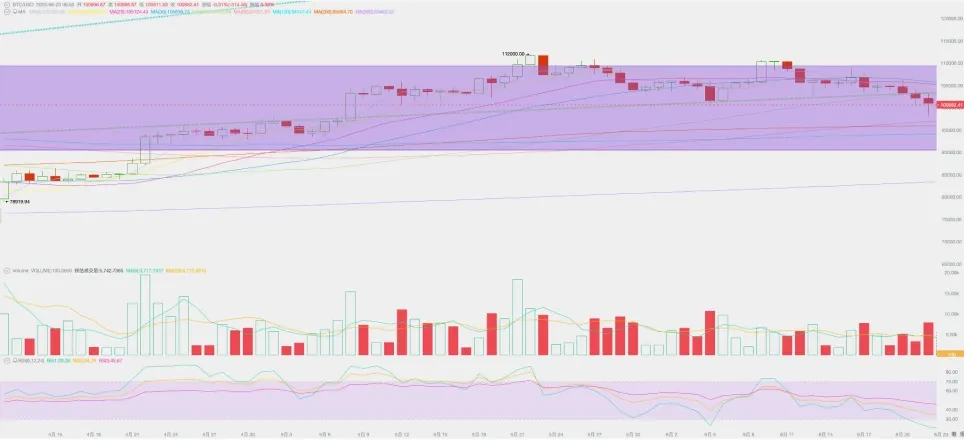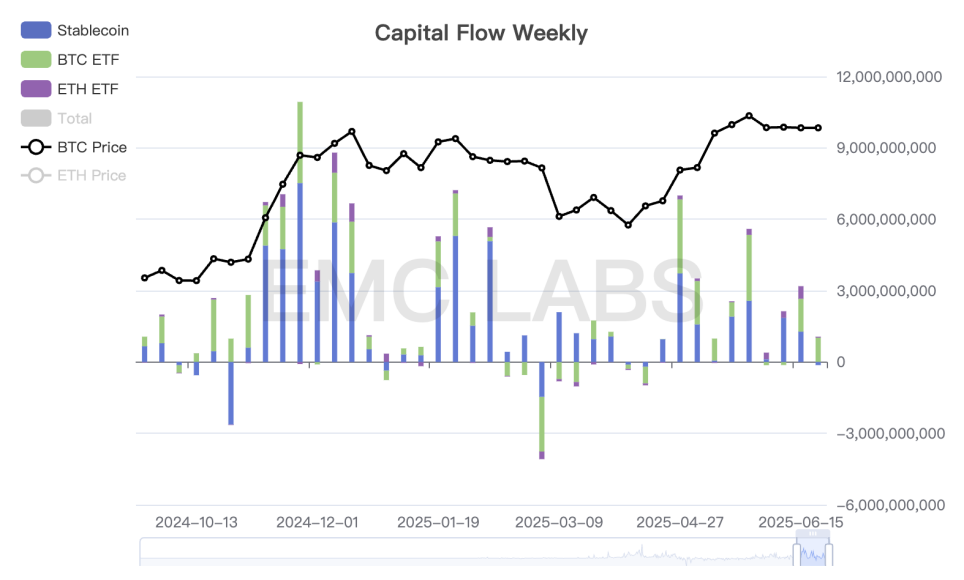
The information, opinions, and judgments regarding the market, projects, and cryptocurrencies mentioned in this report are for reference only and do not constitute any investment advice.

This week, crypto assets experienced a triple intertwining of "institutional funds providing support, rising caution in derivatives, and a sudden amplification of geopolitical risks."
BTC continued to test the $102,000-$109,000 range and saw a brief panic drop over the weekend due to the US attack on Iranian nuclear facilities, followed by some recovery.
The internal structural forces within the crypto market remained intact, providing important support for price stability. However, due to the escalation of geopolitical conflicts, short-term traders priced BTC downward.
Subsequently, under stable internal structures, BTC's future movements will entirely depend on whether the Israel-Iran conflict continues to escalate, such as if Iran directly supplies US military bases and ships, or even blocks the Strait of Hormuz. If the conflict gradually resumes, BTC is likely to return to the $105,000 level.
Policy, Macro Finance, and Economic Data
This week, the Israel-Iran conflict escalated in a spiral manner.
From June 16 to 18, Israel continued to launch "surgical" airstrikes targeting missile sites and Shiite militia command centers within Iran; Iran subsequently retaliated with ballistic missiles and drones, raising the temperature of the battlefield. The market then entered a defensive mode: Brent crude oil rose nearly 7% over the week, briefly surpassing the $78 mark; gold also climbed, reaching a peak of $33,452.37 per ounce.
On June 19, the White House publicly stated for the first time that it was "evaluating military options," marking a critical point where the US shifted from behind-the-scenes coordination to open intervention. On the day the news was released, Brent crude futures rose another 2.8%, closing at $78.85, a five-month high; the VIX volatility index increased, while US Treasury yields fell in a flight to safety.
A brief easing occurred on June 20—markets speculated that Washington might conclude with additional sanctions rather than military action, leading to a slight pullback in oil prices and a technical rebound in global stock indices.
However, just a day later, this optimism of "sanctions replacing strikes" was completely shattered: US President Trump ordered three B-2 stealth bombers to carry GBU-57 "massive bunker busters" to conduct precise bombings on Iran's Fordow, Natanz, and Isfahan uranium enrichment facilities. In a televised address, Trump claimed that "key core capabilities have been reset to zero," suggesting that if Iran was willing to negotiate, the actions could come to a halt.
This move immediately triggered severe diplomatic shockwaves. UN Secretary-General Guterres described the situation as "extremely precarious," while the EU and the UK condemned Iran's nuclear ambitions while urging restraint from all parties. Iran's foreign minister accused the US of "openly violating the UN Charter," vowing to take "proportional or asymmetric retaliation," and hinted at not ruling out a "selective blockade" of the Strait of Hormuz. Subsequently, the Iranian parliament passed a resolution allowing the closure of the Strait of Hormuz (which would affect 20% of global oil exports), with the final decision to be made by Iran's Supreme National Security Council.
As the airstrikes occurred during the weekend market closure, the pricing in mainstream financial markets awaited Monday's revelation. However, derivatives and offshore trading had already provided forward signals: energy and military ETFs rose in after-hours trading; CME crude oil options saw significant volume at the $90 execution price range; while high-risk crypto assets faced selling pressure first, with BTC dropping about 1.14% and ETH seeing a decline of over 2.96%.
In last week's report, we stated: the short-term BTC trend depends on the progress of "geopolitical conflicts." If the conflict escalates, risk assets, including BTC, will remain volatile or even price downward; if the conflict eases, equity assets may gradually recover from losses.
This week, the US's direct intervention escalated the conflict, pushing BTC down 4.36% to $46,602.38 for the week. If Iran's retaliatory actions involve supplying US military bases or "blocking" the Strait of Hormuz, it will further impact the downward pricing of global US stocks and crypto assets.
This week's events have pushed the Middle East situation into a gray area between "controllable confrontation" and "proxy escalation," with the market entering a typical "oil inflation—US Treasury safe-haven—tech correction—precious metals favored" pattern. If Iran's retaliation is constrained by domestic political and military capabilities in the coming weeks, the market may digest in high volatility; however, if the conflict further spills over into maritime energy routes or US military positions, the magnitude and pace of global asset repricing will significantly intensify.
Historical data shows that BTC often initially retreats at the onset of geopolitical crises, followed by a weak negative correlation recovery with gold; however, if the conflict evolves into a dual squeeze on global liquidity and funding costs, the sensitivity of Bitcoin and Ethereum will be significantly amplified.
Crypto Market
This week, crypto assets experienced a triple intertwining of "institutional funds providing support, rising caution in derivatives, and a sudden amplification of geopolitical risks." BTC continued to test the $102,000-$109,000 range and saw a brief panic drop over the weekend due to the US attack on Iranian nuclear facilities, followed by some recovery.
At the beginning of the week, expectations for the "controllability" of the Israel-Iran conflict brought a slight recovery: BTC rebounded to a high of $109,000, with Bitcoin spot ETF seeing net inflows for eight consecutive trading days. This funding data provided crucial support for prices amid macro noise. Against the backdrop of cooling on-site funds, institutional buying power became the main force keeping BTC prices above $100,000.
Subsequently, the FOMC results released on June 19, which indicated "no change + dot plot slowdown," did not disrupt BTC's oscillation rhythm, but the futures market showed an increase in hedging scale.
After Friday's trading, data showed that ETH ETF experienced the largest single-day net outflow of June (11.3 million USD), leading to a chain reaction of deleveraging due to institutional reduction of positions, with ETH's dollar quote plunging to $2,372, and trading volume increasing, dragging down high β assets like SOL and DOGE.
During the US trading session on June 20, a round of high-leverage squeeze caused BTC to quickly drop below $103,000, with over 90% being long positions; ETH and SOL saw declines of up to 6-9%. This "flash crash" event confirmed the fragility of excessive leverage on the derivatives side and marked the first large-scale systemic liquidation since the rapid rise in May.
The weekend risk peak occurred in the early hours of June 21-22 (Eastern Time): the news of the US B-2 bombers precisely striking three Iranian uranium enrichment facilities broke the weekend liquidity vacuum. As the only major asset class trading in real-time 24/7 globally, BTC briefly fell below $100,000 but closed down 1.14%, showing relative strength. However, ETH, after two consecutive days of nearly 10% decline, fell again by 2.96%, indicating that the liquidity of high-risk assets is very fragile.
From a technical indicator perspective, the geopolitical conflict caused BTC to temporarily break below the first upward trend line but still operates within the $90,000-$110,000 range. We believe that the structured tension in the market remains intact, and the changes in funding support are minimal. BTC's downward pricing this week is due to panic emotions triggered by the escalation of geopolitical conflicts. If the conflict escalates further, this impact will gradually dissipate, but if the conflict continues to escalate, it will test the key support levels of $100,000 and $90,000.
Capital Inflows and Outflows
After the significant rebound in April and May, capital inflows have shown divergence, with stablecoin channel funds beginning to weaken, while BTC Spot ETF channel funds remain relatively strong and stable.
This week, BTC Spot ETF channel funds saw an inflow of $1.022 billion, significantly down from last week's $1.384 billion, but still maintaining a high level. However, this data may face significant challenges next week; if geopolitical conflicts continue to cool US stocks, BTC Spot ETF channel funds are unlikely to show an independent trend.

Crypto Market Capital Inflow Statistics (Weekly)
Stablecoin channels saw an inflow of $1.273 billion last week, but this week turned into an outflow of $132 million. This rapid cooling aligns with the trends we observed in the contract and lending markets.
This week, ETH Spot saw an inflow of $40.77 million, with inflow scale shrinking in the first half of the week, turning into an outflow of over $100 million by Friday. The reduction in ETH inflow scale may put pressure on high β assets. A flash crash could cause significant damage to the market.
Selling Pressure and Liquidation
In the context of delayed interest rate cuts and rising geopolitical peaks, BTC prices have maintained high levels between $10 and $12, with decisive forces coming from institutional allocations and structural tension in the market.
This week, long positions increased by 28,920 BTC, while short positions decreased by 24,650 BTC, and the inventory on centralized exchanges continued to decrease. Due to panic selling and weakened speculative enthusiasm, the outflow scale from exchanges significantly decreased to 1,555.9 BTC this week.
The above data may indicate that long-term holders' confidence in BTC is continuing to strengthen, while short-term traders' enthusiasm is cooling more rapidly. The short-term pricing power of BTC is jointly determined by on-site short-term traders and BTC Spot ETF channel funds. Currently, both are showing signs of cooling. If the Israel-Iran conflict is resolved quickly, BTC may turn from danger to safety and return to the $105,000 level; if it worsens, it is likely to fall below the $100,000 level, and even test $90,000 (though this is less probable).
EMC Labs believes that the logic of BTC's medium to long-term price trend has not changed, unless the Israel-Iran conflict evolves into a regional war involving US intervention.
Cycle Indicators
According to eMerge Engine, the EMC BTC Cycle Metrics indicator is at 0.625, indicating an upward phase.
EMC Labs
EMC Labs was established in April 2023 by crypto asset investors and data scientists. It focuses on blockchain industry research and investments in the crypto secondary market, with industry foresight, insights, and data mining as core competencies, aiming to participate in the thriving blockchain industry through research and investment, promoting the benefits of blockchain and crypto assets for humanity.
For more information, please visit: https://www.emc.fund
免责声明:本文章仅代表作者个人观点,不代表本平台的立场和观点。本文章仅供信息分享,不构成对任何人的任何投资建议。用户与作者之间的任何争议,与本平台无关。如网页中刊载的文章或图片涉及侵权,请提供相关的权利证明和身份证明发送邮件到support@aicoin.com,本平台相关工作人员将会进行核查。




